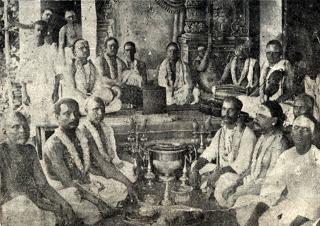
Sukarthi va tyajeth vidya Vidyarthi va thyajeth sukam Sukarthinaha kutho vidya Vidyarthinaha kutho sukam He who is seeking knowledge should give up comfort, He who is seeking comfort should give up learning knowledge, As the knowledge seeker can not get comfort and a comfort seeker can not learn knowledge.
Life as simple as it is...
Keep in mind that all Truth is beyond Religion. Religion is separating, whereas truth and spirituality is unifying.
You don't have to be Hindu in order to benefit from its Truth. We are all human; every other label we place on ourselves is limiting, and separating.
The greatest spiritual masters and Avatars that ever lived all taught the same things. Religion, background, and culture had nothing to do with their teachings.We are all one creation. There is only one infinite field of consciousness, and we are all part of this field.
Friday, September 25, 2009
What is a mridangam?
The two mouths or apertures of the drum are covered with a goat skin leather and laced to each other with leather straps
around the circumference of drum. These straps are put into a state of high tension to stretch out the circular membranes on
either side of the hull, allowing them to resonate when struck. These two membranes are dissimilar in width to allow for the
production of both bass and treble sounds from the same drum.
The bass aperture is known as the "thoppi" or "eda bhaaga" and the smaller aperture is known as the "valanthalai" or "bala
bhaaga". The smaller membrane, when struck, produces higher pitched sounds with a metallic timbre. The wider aperture
produces lower pitched sounds. The goat skin covering the smaller aperture is anointed in the center with a black disk made
of rice flour, ferric oxide powder(rock powder) and starch. This black paste is known as the "sAtham" or "karnai" and gives
the mridangam its distinct metallic timbre. The combination of two inhomogeneous circular membranes allows for the production
of unique and distinct harmonics. Pioneering work on the mathematics of these harmonics was done by Nobel Prize winning
physicist C. V. Raman.
Immediately prior to use in a performance, the leather covering the wider aperture(left side for right handed mridangists) is
made moist and a spot of paste made from rava flour and water is applied to the center, which lowers the pitch of the left
membrane and gives it a very powerful resonating bass sound. The artist tunes the instrument by varying the tension in the
leather straps spanning the hull of the instrument. This is achieved by placing the mridangam upright with its larger side
facing down, and then striking the tension-bearing straps located along of circumference of the right membrane with a heavy
object (such as a stone). A wooden peg is sometimes placed between the stone and the mridangam during the tuning procedure to
ensure that the force is exerted at precisely the point where it is needed. Striking the periphery of the right membrane in
the direction toward the hull raises the pitch, while striking the periphery from the opposite side (moving away from the
hull) lowers the pitch. The pitch must be uniform and balanced at all points along the circumference of the valanthalai for
the sound to resonate perfectly. The pitch can be balanced with the aid of a pitch pipe or a tambura. The larger membrane can
also be tuned in a similar manner, though it is not done as frequently. Note that since the leather straps are interwoven
between both the smaller and larger aperture, adjusting the tension on one side often can affect the tension on the other.
The mridangam is played resting it parallel to the floor. A right-handed mridangam artist plays the smaller membrane with his
or her right hand and the larger membrane with the left hand. This can be described in words as follows: The mridangam rests
upon the right foot and ankle, the right leg being slightly extended, while the left leg is bent and rests against the hull
of the drum and against the torso of the artist. For a left-handed percussionist, the legs and hands are switched.
Students of this art are required to learn and vigorously practice both the fingering strokes taught as the training becomes
more advanced, which are generally used as aesthetic embellishments while playing.The combination of these finger strokes
produces complex mathematical patterns.
Today the mridangam is most widely used in Carnatic music performances. These performances take place all over Southern India
and are now popular all over the world. As the principle rhythmic accompaniment (pakkavadyam), the mridangam has a place of
utmost importance, ensuring all of the other artists are keeping their timing in check while providing support to the main
artist. One of the highlights of a modern Carnatic music concert is the percussion solo (thani avarthanam), where the
mridangam artist and other percussionists such as kanjira, morsing, and ghatam vidwans exchange various complex rhythmic
patterns, culminating in a grand finale where the main artists resumes where he or she left off. Mridangam is used as an
accompanying instrument in Yakshagana Himmela (orchestra) where it is called Maddale. However, Mridangam used in Yakshagana
is markedly different in structure and acustics from the ones used in Carnatic music.